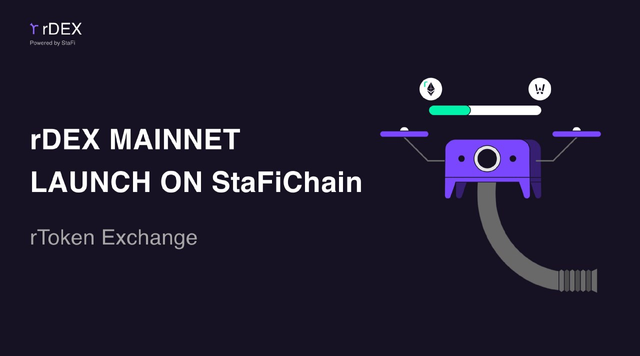rDEX Launches On Mainnet

Weeks ago, StaFi commenced the development of rDEX, a decentralized exchange for trading its staking derivatives (rTokens). This move has received mixed reactions in the crypto space and beyond.
Here, we intend to dig into the facts about the rDEX. Let’s get to it.
Features Of The rDEX
To understand why the decentralized exchange became a thing, here are some of its features:
1.Support For Low Slippage
One of the challenges users face on many decentralized exchanges is tied to slippage. Since DEXs revolve around market orders, a high slippage can alter the price of a transaction. On rDEX, low slippage is supported thanks to a fee model that reduces the likelihood of a significant change in price. Users of the DEX are certain to be pleased with that.
2.Improved Liquidity
The prowess of a DEX is hinged on the liquidity available. rDEX uses Thorchain’s market maker model to guarantee adequate liquidity for the trading of rTokens. Previously, StaFi relied on liquidity providers across different DEXs to ensure rTokens can be easily traded. That has changed with the launch of rDEX. Now, it’s one DEX to trade them all.
3.Unique Liquidity Pool
Decentralized exchanges often require liquidity providers to add equal amounts of assets to the pool. If you don’t have the right amount of assets, you will need to sell off to create a balance. rDEX offers something better with its asymmetrical liquidity deposit, which eliminates the need to rebalance your asset.
3.Supported Trading Pairs
The rDEX has been developed to allow for the trading of several rTokens against the native token, FIS. Since the decentralized exchange is currently deployed on StaFi’s own chain, only rtokens on that chain can be traded directly. rETH is the only staking derivative that can’t be traded directly (uses a bridge) since it has ties to the Ethereum chain.
Supported trading pairs on the rDEX include:
rDOT/FIS
rATOM/FIS
rBNB/FIS
rMATIC/FIS
rSOL/FIS
rETH/FIS
Benefits Of The rDEX
Though decentralized exchanges are not in scarce supply, rDEX brings a lot to the table. Here are some of the benefits of the rDEX:
1.rToken Liquidity
In the past, rTokens trading posed a challenge due to a lack of liquidity on several decentralized exchanges. With the deployment of the rDEX, liquidity for rTokens is no longer a problem. You can easily trade any of the supported rTokens for FIS, an utility token that is currently listed on several centralized exchanges like Binance and Huobi.
2.Cheaper Gas Fees
On the rDEX, gas fees are cheaper and unified. The decentralized exchange is deployed on the StaFi chain, so fees are paid in FIS, and it’s quite affordable compared to what you’d pay for trading rTokens on the supported DEXs.
3.Protection From Impermanent Loss
By using the rDEX, users are shielded from impermanent loss. The decentralized exchange uses an asymmetrical approach to liquidity provision, reducing the risk of impermanent loss.
Facts About the rDEX
With the rDEX being the first decentralized exchange for trading staking derivatives, it’s always good to isolate the facts from the hearsays. Here are what we know about the rDEX:
1.Total Value Locked (TVL) is Rising
DEXs are often ranked based on TVLs, and the rDEX, though a staking derivatives exchange, is no different. At the moment, the rDEX’s TVL is over the $1m mark, which is quite significant for a DEX that has only recently gone live on mainnet. The increasing TVL suggests overwhelming confidence in what Staking Finance is building.
2.Security Audit Completed
Decentralized exchanges like the rDEX are often the subject of hacks and exploits. To protect the DEX, audits are carried out to check for vulnerabilities. rDEX was recently in the testnet phase to identify such flaws in the exchange. Interestingly, the Peckshield audit and the bug bounty exposed certain vulnerabilities with varying risk levels. StaFi has made the necessary changes to the codes of rDEX, ensuring the decentralized exchange is safe for use.
3.Insurance Fund
StaFi protocol is an embodiment of the ‘funds are SAFU’ mantra. The rDEX reflects that safety standard with the creation of an insurance fund, which will provide a cushion for users against hacks and exploits.
The insurance fund will consist of several currencies, including StaFi’s native token, FIS. A proposal is in the works to allocate $5m worth of FIS to the insurance fund. If that proposal sails through, the rDEX insurance war chest will get a big boost. That should give users the confidence to use the DEX without worrying about the safety of their assets. It’s certainly a good move that should work in favor of the rDEX.
4.A Liquidity Mining Feast
Everyone knows StaFi doesn’t play when it comes to liquidity mining, and the launch of rDEX provides the DeFi protocol with another opportunity to impress. A liquidity mining program for rDEX is being finalized. The details are still cloudy, but more information will be available in the coming weeks. At the moment, interested liquidity providers can go through the proposal for the program, so they are certain of what to expect.
Conclusion
StaFi’s rDEX holds the key to the future of its rTokens. If the decentralized exchange delivers on the expectations of users while surviving the numerous attacks aimed at DEXs, then the protocol has taken a major step towards achieving its goals for POS chains.
The rDEX going live on mainnet is a new chapter for StaFi, liquid staking, and POS chains. Hopefully, it’s the beginning of something big for everyone.
Official Websites
Website: www.stafi.io
rDEX: https://app.rdex.finance/
Telegram Chat: https://t.me/stafi_protocol
Telegram Announcements: https://t.me/stafi_ann
Discord: https://discord.com/invite/jB77etn
Forum: https://commonwealth.im/stafi